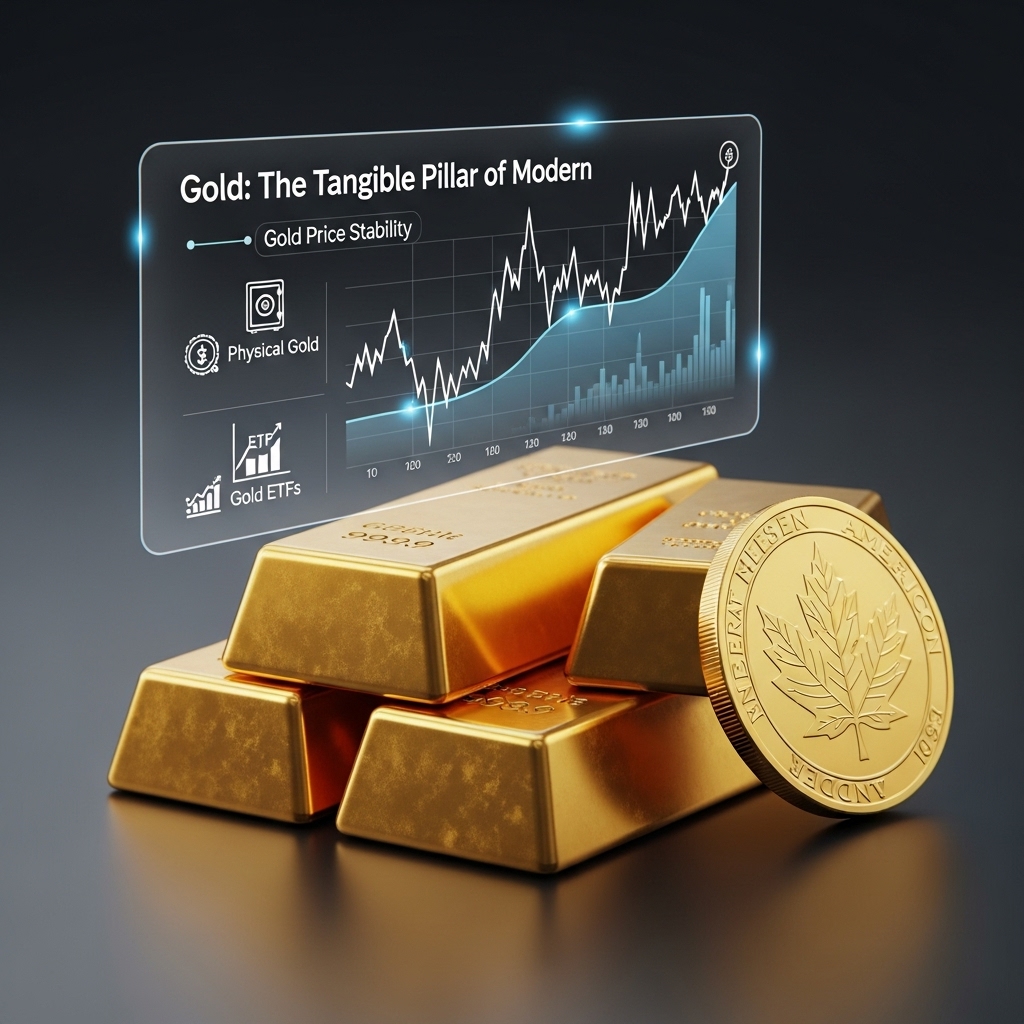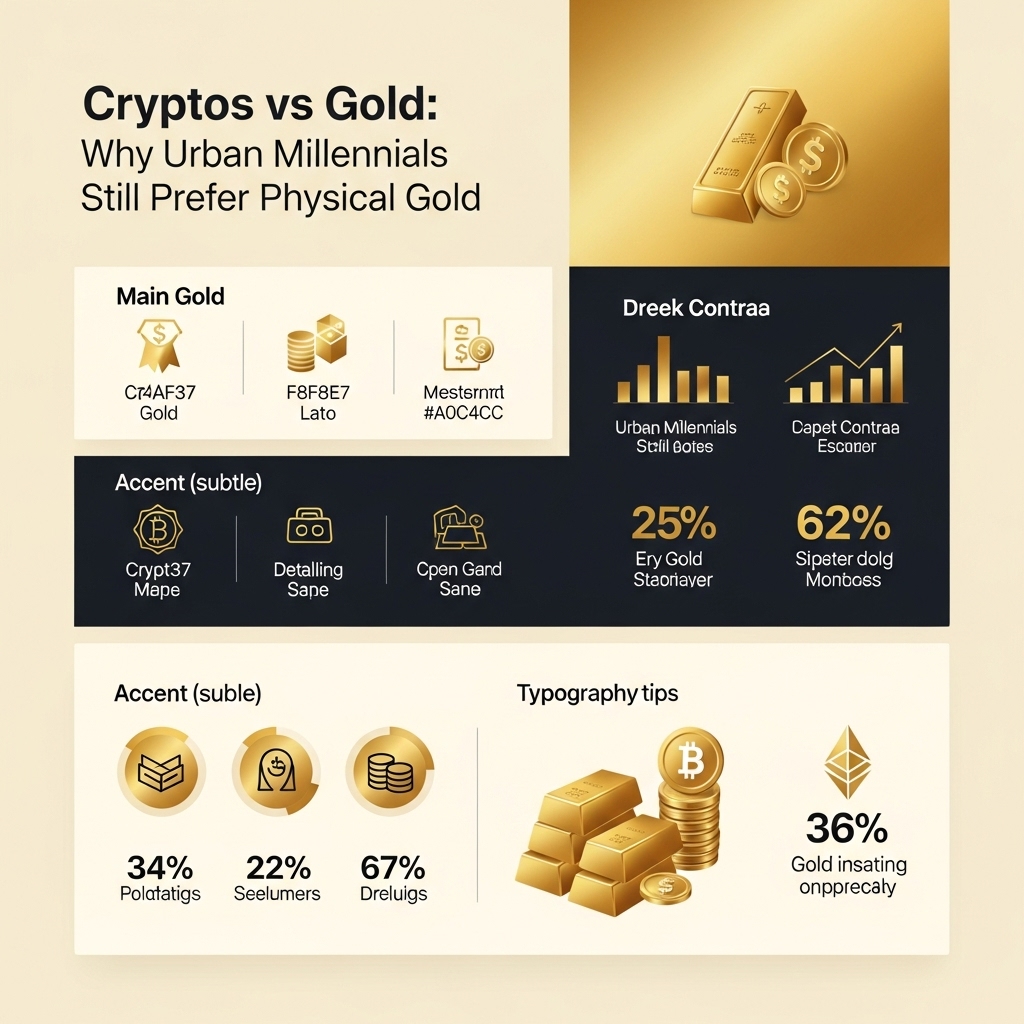Cryptos vs Gold: The Enduring Allure of Physical Gold for Urban Millennials
As the digital age sprints forward and cryptocurrencies like Bitcoin and Ethereum dominate financial headlines with their dizzying highs and gut-wrenching lows, a curious counter-trend is emerging: urban millennials, often synonymous with tech-savviness and digital-first living, are increasingly turning their attention towards something far older and more tangible – physical gold. While the allure of decentralized digital assets is undeniable, gold has once again demonstrated its unwavering resilience, recently hitting record highs and solidifying its role as a premier safe-haven asset amidst global economic uncertainties. This begs the question: why are young, forward-thinking investors choosing the glint of bullion over the blockchain? This post will delve deep into this fascinating dynamic, exploring the compelling reasons behind this demographic’s growing preference for physical gold.
For any investor, understanding market sentiment and underlying trends is crucial, and this shift among a key demographic speaks volumes about gold’s enduring value proposition. We’ll unpack the unique financial benefits that physical gold offers, from its proven track record as an inflation hedge and a stable store of wealth to its tangible nature providing a sense of security that digital assets simply cannot match. We’ll analyze current market trends that underscore gold’s robust performance, contrasting its predictable stability with the often-volatile ride of cryptocurrency markets. By the end, you’ll gain a clearer perspective on why, for urban millennials seeking long-term financial security and diversification, the ancient gleam of gold continues to outshine the digital dazzle of crypto.
Gold Market Analysis and Key Insights
Despite the allure of high-growth digital assets, physical gold continues to hold significant appeal, particularly among urban millennials seeking tangible security. Its enduring role as a safe-haven asset anchors its position in diversified portfolios.
Perceived Stability Amidst Volatility
Gold’s primary draw lies in its historical track record as a stable store of value, especially during periods of economic uncertainty or geopolitical instability. Unlike the inherent volatility of cryptocurrencies, gold typically exhibits a more predictable, albeit slower, appreciation, acting as a crucial buffer against market downturns. This perceived steadfastness offers a psychological comfort that digital, intangible assets often cannot.
Inflation Hedge Appeal
With global inflationary pressures persisting, gold’s traditional function as an inflation hedge has regained prominence. It is widely regarded as a protective asset against currency devaluation, preserving purchasing power over the long term. This characteristic is particularly attractive to investors wary of central bank policies and the erosion of fiat currency value.
Tangibility and Trust
For many, the physical nature of gold bullion, coins, or bars provides an unparalleled sense of security and ownership. This tangibility fosters trust, a stark contrast to the abstract nature of cryptocurrencies, which rely on digital ledgers and decentralized networks. The ability to physically hold wealth resonates deeply, mitigating concerns about cyber threats or technological failures.
Current Gold Market Trends and Data: The gold market has demonstrated robust performance, frequently testing and setting new all-time highs driven by sustained central bank buying, persistent geopolitical tensions, and ongoing inflation concerns. Demand from retail investors, including millennials, for physical gold products remains consistent, underpinning its market strength even as interest in digital assets fluctuates.
Investment Benefits and Considerations: Gold offers significant portfolio diversification, acting as a non-correlated asset that can reduce overall risk. It provides excellent liquidity, making it relatively easy to buy and sell. However, investors must consider storage costs for physical gold and its lack of passive yield compared to interest-bearing assets.
Expert Recommendations: Financial advisors frequently recommend allocating a portion of an investment portfolio—typically between 5-10%—to gold. This allocation is primarily for portfolio diversification and as a hedge against inflation and market volatility. Experts emphasize that gold should be viewed as a long-term wealth preservation tool rather than a speculative short-term gain asset.

Gold Investment Strategies and Options
For urban millennials drawn to gold’s enduring value, a strategic approach is key. Physical gold remains a cornerstone, offering a tangible asset through purchases of gold bars, coins (like American Eagles or Canadian Maples), or jewelry. This direct ownership provides security and a hedge against system failures, resonating with those wary of digital vulnerabilities. However, physical gold requires secure storage and can incur transaction costs, making liquidity lower than other options.
Beyond physical holdings, Gold Exchange-Traded Funds (ETFs) like GLD or IAU offer an accessible way to track gold’s price without the hassle of physical storage. They provide high liquidity and lower entry barriers, though they lack the tangibility many millennials seek. Investing in gold mining stocks (e.g., Barrick Gold, Newmont) offers leverage to gold price movements, potentially yielding higher returns, but introduces company-specific risks beyond just gold’s performance.
Risk assessment and portfolio allocation are crucial. Gold typically acts as a safe-haven asset, diversifying a portfolio and hedging against inflation, economic downturns, and geopolitical instability. Financial advisors often suggest allocating 5-15% of a diversified portfolio to gold, depending on an individual’s risk tolerance and economic outlook. For millennials prioritizing stability, a higher allocation within this range might be suitable, contrasting sharply with the often volatile nature of cryptocurrencies.
When comparing methods, physical gold appeals for its inherent value and lack of counterparty risk, while ETFs offer convenience and liquidity. Mining stocks provide growth potential but carry equity-market risks. Market timing considerations for gold often involve global economic uncertainty, high inflation periods, or a weakening U.S. dollar, as these scenarios historically boost gold’s appeal. For urban millennials seeking wealth preservation over speculative gains, a long-term holding strategy, accumulating gold during dips, typically aligns with its role as a stable store of value.
Market Performance and Outlook
For decades, gold has served as a reliable store of value, a perception amplified by its historical performance. Over the long term, gold has consistently outpaced inflation and demonstrated resilience during periods of economic uncertainty. For instance, looking at the last 50 years, gold has delivered substantial returns, especially when compared to fiat currencies that have experienced significant devaluation. This track record provides a tangible reason for its enduring appeal.
Currently, gold is navigating a complex economic landscape. While inflation remains a concern for many, rising interest rates in major economies have presented a headwind, increasing the opportunity cost of holding a non-yielding asset like gold. However, geopolitical tensions and ongoing supply chain disruptions continue to fuel demand for safe-haven assets, providing underlying support.
Looking ahead, the outlook for gold remains cautiously optimistic. Persistent inflation, even if moderating, alongside potential economic slowdowns, could reignite investor interest in gold. Factors such as central bank diversification strategies, continued geopolitical instability, and potential shifts in monetary policy easing could further bolster gold prices. While cryptocurrencies offer high growth potential, their inherent volatility and regulatory uncertainties mean that for many urban millennials, the tangible security and historical performance of physical gold continue to make it the preferred investment for wealth preservation.
Frequently Asked Questions About Gold Investment
Is physical gold a safe investment in today’s digital world?
Yes. Unlike digital assets prone to cyber threats, physical gold is tangible and exists outside financial systems. It offers a direct, unhackable hedge against market instability, providing secure, lasting value independent of digital vulnerabilities.
How does physical gold protect against inflation compared to other assets?
Gold historically serves as a strong inflation hedge. As currency values decline, gold typically retains or increases its purchasing power. Its intrinsic value makes it a reliable store of wealth, preserving capital effectively during economic uncertainty.
Why do urban millennials, often tech-savvy, still choose physical gold over cryptocurrencies?
Many millennials value gold’s proven history, tangible nature, and lack of counterparty risk. Its universal recognition and stability during crises offer a secure, long-term wealth preservation option that volatile, newer assets like crypto haven’t yet matched.
What are the main benefits of holding physical gold for long-term wealth preservation?
Physical gold offers portfolio diversification and acts as a safe haven during market downturns. It protects purchasing power, carries no credit risk, and is a universally accepted, tangible asset suitable for generational wealth transfer.
Are there storage and liquidity challenges with physical gold?
Yes, physical gold requires secure storage (e.g., home safes, insured vaults). While not instantly liquid, it’s highly convertible to cash globally via reputable dealers. The security and permanence of a tangible asset often outweigh these logistical considerations.

Final Thoughts on Gold Investment
Despite the digital allure of cryptocurrencies, physical gold continues to resonate with urban millennials seeking stability and tangible security. Its proven track record as a hedge against inflation and market volatility, coupled with its intrinsic value, makes it a reliable cornerstone in an uncertain financial landscape. For those prioritizing long-term wealth preservation and diversification, gold isn’t just an option; it’s a strategic necessity. It offers a tangible counter-balance to the inherent risks of digital assets, providing a foundational element of real-world value. Therefore, our recommendation remains clear: integrate physical gold into your investment portfolio. Secure your financial future with this timeless asset – explore your options for acquiring physical gold today.